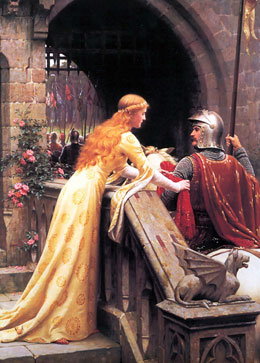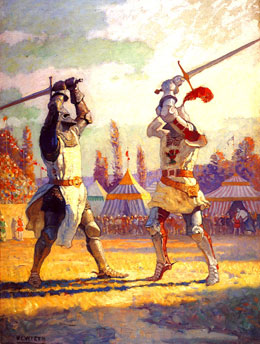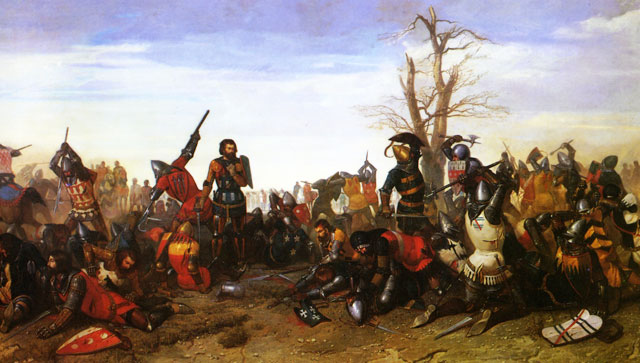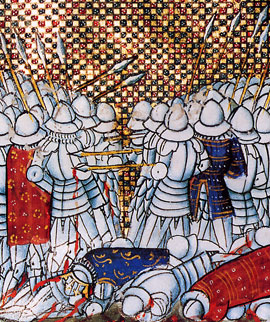The Combat of the Thirty
Knightly deeds in a dirty little war
 Many people with an interest in war in the Middle Ages succumb to the temptation to
confuse the reality of how it was with a romantic ideal of the spectacle of knights in
battle. Of course, it was sometimes possible that wars were quickly decided by such
dramatic combat, but if they dragged on, which they normally did, battles and even sieges
became rare exceptions. Instead the fighting devolved into raids, ambushes, devastation
and looting. Such tactics allowed fighting to continue by providing funding for troops,
while simultaneously depleting the enemy's financial resources. No wonder then that these
armies quickly mutated into little more than bands of robbers. Chivalry - at least in the
modern understanding - was mainly conspicuous by its absence. These "knights"
were often too busy collecting ransom money to go out and loot, torture prisoners or
extort the last piece of bread from starving peasants.
Many people with an interest in war in the Middle Ages succumb to the temptation to
confuse the reality of how it was with a romantic ideal of the spectacle of knights in
battle. Of course, it was sometimes possible that wars were quickly decided by such
dramatic combat, but if they dragged on, which they normally did, battles and even sieges
became rare exceptions. Instead the fighting devolved into raids, ambushes, devastation
and looting. Such tactics allowed fighting to continue by providing funding for troops,
while simultaneously depleting the enemy's financial resources. No wonder then that these
armies quickly mutated into little more than bands of robbers. Chivalry - at least in the
modern understanding - was mainly conspicuous by its absence. These "knights"
were often too busy collecting ransom money to go out and loot, torture prisoners or
extort the last piece of bread from starving peasants.
Like shining beacons the spectacular English victories of Crecy (1346) and Maupertuis (1356) lit up the first phase of the Hundred Years' War. But what happened in between? While there was no pause in the fighting, one gets the impression that events became obscured in the darkness between the blaze of these two battles. Looking for more specific information, you may stumble upon - in a very remote corner - the war in Brittany. There, after the death of the old Duke in 1341, fighting broke out between two noble factions over the succession in the duchy. One group had formed around Charles of Blois, the husband of the niece of the Duke. Because Charles of Blois was approved by the French king, it was only natural that the English supported his competitor, John of Montfort, the step-brother of the old Duke.
The war finally ended in 1364 after more than twenty years, with the death of Charles of Blois in the Battle of Auray. Since the English concentrated their forces mostly in the north in Flanders or in the south in Gascony, Brittany was almost always a neglected sideshow and wasn't allowed to become too much of a financial drain. The troops were therefore largely left to themselves. Very often groups composed of only a few dozen warriors seized castles or another fortified places, most commonly during night raids. They then extorted protection money, the so called "Patis", in the controlled area and undertook raids into the enemy's lands. Both sides constantly employed a good number of foreign mercenaries (German, Flemish, Savoyard, Genoese), but over time the involved British and Bretons also developed an increasingly mercenary mentality.
This kind of war attracted above all adventurers who tried to make their fortune as independent subcontractors of the crown. Furthermore the English used the garrisons as a kind of penal colony, into which convicted criminals were thrown to do military service. Jonathan Sumption, the leading expert on this period of history describes the scene in the following way: "A growing proportion of adventurers and ruffians: outlaws, escaped jailbirds, convicted rapists and murderers. [...] they were neither knights nor squires but worthless fellows, men without loyalties or standards who would not serve a moment longer than their twelve pence a day and forty marks a year."
 While everyday life in this dirty little war was determined by men who from today's
perspective would be referred to as bloodthirsty bandits under the leadership of ruthless
warlords, the glorification of knightly virtues nevertheless reached new pinnacles.
Everyone who could afford weapons typical of a knight and expensive horses wanted to be
treated as a man of position and honor, and was always ready to defend his reputation in
a duel. Nobody considered it reprehensible to maim peasants, to waylay peaceful travelers
or to plunder churches.
While everyday life in this dirty little war was determined by men who from today's
perspective would be referred to as bloodthirsty bandits under the leadership of ruthless
warlords, the glorification of knightly virtues nevertheless reached new pinnacles.
Everyone who could afford weapons typical of a knight and expensive horses wanted to be
treated as a man of position and honor, and was always ready to defend his reputation in
a duel. Nobody considered it reprehensible to maim peasants, to waylay peaceful travelers
or to plunder churches.
The only important thing was etiquette within the warrior caste itself, and in this the war offered many opportunities for advancement, even to those who had come to Brittany merely as a servant in the retinue of a knight. Tournaments were especially valued, and sometimes even knights from the opposition received safe conduct so that they could also take part. Before battles and during sieges opponents were also frequently challenged to a duel, and while these fights had no military effect at all, the winner could sometimes gain more fame from a duel than by participating in a real battle.
The history of the Hundred Years War is full of such ritualised duels, to which poets and chroniclers often devoted more attention and paper than the actual war. The most famous event of this kind occurred in March 1351 in Brittany, between the castle Ploërmel which had an English garrison and the nearby castle Josselin which had a Breton-French one. This was to be the scene of the legendary Combat of the Thirty.
The chronicler Froissart, who counted the event among the most outstanding feats of arms of his time, reports that Jean de Beaumanoir, the commander of the "French", challenged the English to a duel for the glory and entertainment of their ladies.
The warden of Ploërmel, a German mercenary named Brandebourch ("ung souldoyer d'Alemaigne qu'on appeloit Brandebourch") replied thereupon that the ladies would hardly be entertained by a single duel, which would rapidly be over. Instead he proposed a battle of two groups of twenty or thirty hand-picked men. When Beaumanoir delightedly accepted an armistice was signed and they agreed to meet the following Wednesday at a specified place between the two castles.
Modern historians assume that the real motivation for the fight was not the "entertainment of their ladies" but the cruel treatment of peasants by the garrison of Ploërmel, who squeezed out the last of the population by detention and torture. Nevertheless, the event was narrated by several chroniclers and Froissart himself later visited Brittany and spoke with witnesses and even met a participant at the French court. There is therefore relatively little controversy about the fighting itself and the names of those involved.
It seems that the French had the upper hand regarding the ancestry of their combatants, since they had no problem nominating nine knights and 21 squires, exclusively Bretons and mostly from known families. The situation was completely different for the men of Ploërmel. Among them there were almost no well-known nobles to be found. Instead their group comprised a typical mix of foreign mercenaries and English adventurers of obscure origin who sought their fortune in Brittany.
English historians have spared no effort to demonstrate that their leader, who is sometimes called "Richard Brambro" or "Brembo", was at least English (everybody wants to be proud of their heroes). However, since the German Margrave of Brandenburg Louis V provided mercenaries to Edward III on several occasions during the initial phase of the Hundred Years' War, it is not unlikely that he was something of a leftover from these troops. Taking that into consideration, his name "Brandenburg" would have been a clear indication that he was not of noble birth. Another German was simply called "l'Alemant Gaultier", which again indicates humble beginnings. In the case of the "German" (today we would say "Dutch") "Croquart" or "Cokart", it is explicitly stated that he came to France as a mere servant. Nevertheless, it is reported that he proved to be the best fighter on that day. A total of six German mercenaries took part in the fight, in addition to four Bretons who, depending on the spelling, are sometimes also interpreted as "Brabanters".
The names of twenty Englishmen are also mostly so insignificant there is little known about them. All the same two of them, who were at this point still early in their careers, later became famous mercenary leaders: Hugh Calveley (or Calverley) and Robert Knolles. Calveley was a small landowner from Cheshire, the old border region to Wales which provided so many mercenaries throughout the war. Calveley had formed there with friends and neighbors a small company of 15 men at arms to make a fortune in Brittany. Knolles had probably started as a simple archer and slowly ascended the ranks until he served as a man at arms.
On the appointed day both groups met, accompanied by their ladies, servants, and a throng of spectators. After they had heard mass, confessed, and received absolution, they formed two lines on foot and attacked. After the impact of the first clash the lines broke up into close combat and fought man to man. At this point the French lost two dead and three wounded, who were taken prisoner. Exhausted after hard fighting, all agreed to a short truce. Each group withdrew, and the combatants received attention from their servants, who bandaged their wounds and replaced the broken pieces of armor and weapons.

They regrouped and resumed the fight. A Breton squire threw himself on Brandebourch and wounded him severely with a lance strike in the face. When Brandebourch tried to get back on his feet, he was slain by another Breton with a battle axe. Both sides were so amazed by the death of the English castellan that the arms rested again for some time. Then Croquart took over command on the English side. He changed tactics and ordered his men to fight in a tightly closed line. In the attempt to break through this wall of steel some Bretons were severely wounded. They finally attacked simultaneously from the front and on both sides and killed four of their opponents. Jean de Beaumanoir, who was wounded in this phase, was covered with blood and complained loudly of thirst. An Englishman is said to have shouted: "Drink your blood Beaumanoir and your thirst will pass!"
But when Croquart took command of the wings and pushed back, it again proved impossible for the Bretons to repel the English. The exhausting fight dragged on with neither side gaining ground until a Breton mounted a horse and drove it firmly against the English line. The worn-out men couldn't withstand. Their line was shattered and they were overwhelmed by the now triumphant Bretons. In the course of this melee they suffered the heaviest casualties of the day. The survivors were taken as prisoners to Josselin, and were released after some time for a ransom. Despite there being no definite numbers it is estimated that the English lost about ten dead and the Bretons four.
While the Combat of the Thirty, five years after the disaster of Crecy, lifted French morale considerably, it had absolutely no effect on the course of the war effort. It does demonstrate a lot however, unlike the more usual two-man duels, about fighting techniques between heavily armed men on foot. Considering that 60 men raged against each other for several hours with swords, battle axes, maces, spears and daggers, the death toll is surprisingly low. Furthermore, most were killed in the final stage, when the English line was broken up and the men could probably barely stand on their legs. Often the physical exhaustion of the combatants is not given enough consideration. What would have happened if, instead of both sides resting to recover before fighting again, fresh troops had appeared, something which had proven to be decisive in so many battles? Normally little could be achieved with a single horse against a closely deployed group of knights, but with the soldiers totally exhausted, they clearly couldn't offer much resistance.
 Hand-to-hand fighting among knights had absolutely nothing to do with the carnage
typically envisioned by Hollywood, where heroes kill one foe after the other, but were in
fact closer to a boxing match in the twentieth round, in which tired and exhausted
fighters shove and push, stumble and grapple. In close combat between knights, bruises
and broken bones seem to have been much more the rule than serious wounds, and it's
probable that in summer more died of heatstroke in their suits of armor than by the
swords of the enemy. The problem is of course that war wouldn't look so awesome if it
depicted knights suffocating unheroically in their armor.
Hand-to-hand fighting among knights had absolutely nothing to do with the carnage
typically envisioned by Hollywood, where heroes kill one foe after the other, but were in
fact closer to a boxing match in the twentieth round, in which tired and exhausted
fighters shove and push, stumble and grapple. In close combat between knights, bruises
and broken bones seem to have been much more the rule than serious wounds, and it's
probable that in summer more died of heatstroke in their suits of armor than by the
swords of the enemy. The problem is of course that war wouldn't look so awesome if it
depicted knights suffocating unheroically in their armor.
Also the idea of knighthood as an enclosed elite is relativised by the Combat of the Thirty. At the European courts noble lineage may well have been of great importance; the war, however, opened many ways to ascend. Calveley came at best from the lower gentry. When he later went to Spain as a great mercenary leader, he possessed palaces and castles, negotiated with kings and married an Aragonese princess. Knolles, who later in peacetime waged war on his own account, was not knighted until 1359 by one of his subordinates. The problem is most evident in the former servant Croquart. When he had achieved not only great fame but also great riches he returned to his native Netherlands, where he accumulated a wealth of possessions.
But, like so many nouveaux riche, he was cut off by the old established nobility, and so he returned to the war in France. There the French king offered him nobility and marriage to a wealthy French Lady. But Croquart kept faith with the English, where his business also benefitted from the war. When he finally died in a riding accident, according to Froissart he left a fortune of 40,000 gold ecus and 30 to 40 excellent war horses.